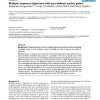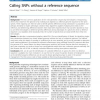73 search results - page 5 / 15 » Genomic multiple sequence alignments: refinement using a gen... |
92
Voted
ALMOB
2006
14 years 10 months ago
2006
Background: Automated software tools for multiple alignment often fail to produce biologically meaningful results. In such situations, expert knowledge can help to improve the qua...
87
Voted
CIBCB
2007
IEEE
15 years 4 months ago
2007
IEEE
—DNA matching is a crucial step in sequence alignment. Since sequence alignment is an approximate matching process there is a need for good approximate algorithms. The process of...
BMCBI
2010
14 years 10 months ago
2010
Background: The most common application for the next-generation sequencing technologies is resequencing, where short reads from the genome of an individual are aligned to a refere...
125
Voted
CP
2003
Springer
15 years 3 months ago
2003
Springer
Multiple sequence alignment is a central problem in Bioinformatics. A known integer programming approach is to apply branch-and-cut to exponentially large graph-theoretic models. T...
76
Voted
ALMOB
2006
14 years 10 months ago
2006
The main goal of the motif finding problem is to detect novel, over-represented unknown signals in a set of sequences (e.g. transcription factor binding sites in a genome). The mo...


